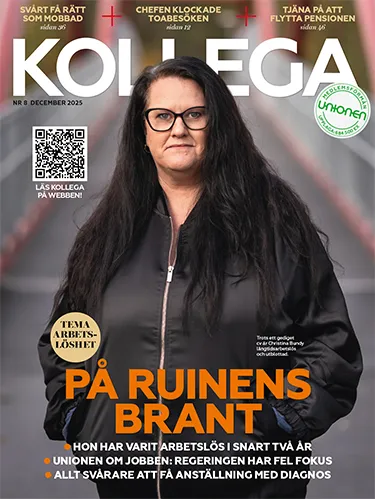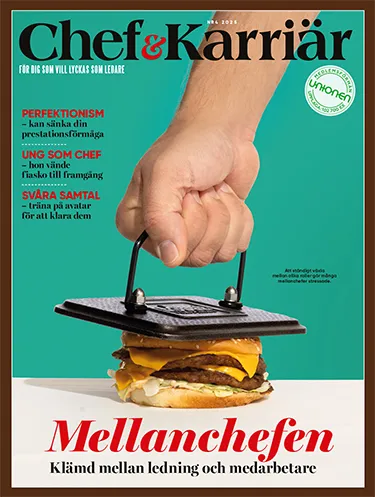Kollegas nyhetsbrev
Är du Unionenmedlem? Prenumererar du inte redan på Kollegas utmärkta nyhetsbrev? Du registrerar dig via länken nedan, och får Kollegas bästa nyheter och tips direkt i din inkorg!
Är du Unionenmedlem? Prenumererar du inte redan på Kollegas utmärkta nyhetsbrev? Du registrerar dig via länken nedan, och får Kollegas bästa nyheter och tips direkt i din inkorg!
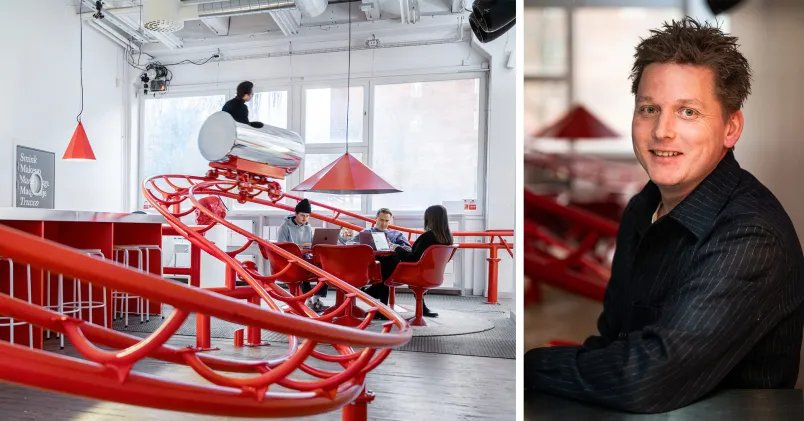
It's not uncommon for advertising agencies and other creative businesses to establish themselves in old factory premises with high ceilings and large windows. But building a 60-meter-long roller coaster – passing over meeting rooms and through the staff canteen – is not quite as common. In fact, the ride at The Great Exhibition's office is the first of its kind in the world. The idea has been with the company's owner, Petter Kukacka, since he was a child.
"I have always been interested in roller coasters and everything that runs on rails. Even in our previous premises, we had loose thoughts about a smaller version, but it fell through due to the low ceiling height. Here we have almost five meters to the ceiling," he says.
It has been a year since the company moved to the thousand-square-meter premises in Stockholm, and Petter Kukacka could start realizing his dream. He emphasizes that the work has been a team effort from the beginning, and the commitment from the employees has been enormous.
"I am probably the one who has worked the least on this. We have taken help from lots of people, but we have designed and planned everything ourselves," he says.
However, building a roller coaster is not something you do in a morning. On the contrary, it turned out to be really complicated – and expensive. After making an initial sketch, The Great Exhibition contacted an expert in the USA whose safety comments led to new insights. A bridge engineer in Sweden calculated the strength, dimensioning of the steel structure, and made drawings. But when the agency started requesting price quotes, they got a real shock.
"We received quotes from roller coaster specialists in Germany and the USA for 3 million $. That was obviously far beyond our budget," says Petter Kukacka.
Many would probably have given up at this point, but not the staff at The Great Exhibition. One of Petter's friends, who is based in China, inquired at various factories in the country and got in touch with China's largest manufacturer of Ferris wheels. The price was acceptable to the advertising agency, and it became a deal – despite the uncertainty about whether the Chinese really understood what they wanted.
"It was a gamble because it was a very unclear deal, and there were some language barriers, but everything has gone smoothly," says Petter Kukacka.
Towards the end of the process, they visited the factory in China to ensure they had manufactured what was ordered and to ensure the quality of the welds and construction.
At the end of June, the four-ton structure arrived in Liljeholmen in a large container. Shortly thereafter, a couple of Chinese experts arrived to assemble the roller coaster in the office environment. The roller coaster car was designed by the design studio on their own, and on October 25th – after a year of intense work – it premiered. To everyone's relief, everything worked perfectly. And it does when Kollega gets to take a test ride:
The ride starts steep and slow, accompanied by a lot of noise. The track then runs above meeting rooms and the kitchen before the car plunges through the canteen and the open office landscape. It's over in less than a minute and offers a real thrill. Additionally, a photo is taken and printed at the end of the ride – just like at any amusement park.
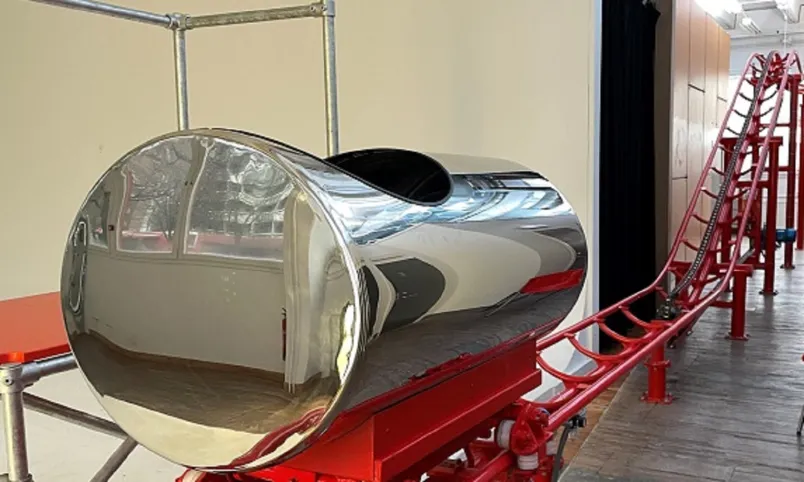
How much is the roller coaster used daily?
"It's not like we jump in and ride every day. But it's certainly running when we have after-work events, and customers and employees' children are very eager to come here and ride."
What has it meant for the workplace?
"The process of creating this together has been very fun and a fantastic way to bring this workplace together in a different way than before. The work of designing and driving the project has forced us to challenge ourselves. It may seem silly, but when you work creatively, it's important to maintain that vein. The pride is great that the track now stands here and that everything actually works."
"Initially, there were some – fully reasonable – objections from employees about why we should do this, and concerns were raised about the noise. An exciting discussion arose about what a workplace really is and how much time we spend at work."
How did you come up with the name 'Frontal Lobe'?
"The frontal lobe is the part of the brain that develops last and makes you rational. It's a reference to the idea that in our creative profession, you might need to remove some of your rational thoughts now and then."
This text has been translated with the help of AI.
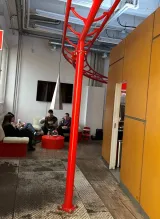
Design studio/advertising agency run by Petter Kukacka for fifteen years. The company has about ten employees and produces, among other things, commercials.
The Frontal Lobe: Roller coaster, approximately 60 meters of track, and reaches a top speed of 30 km/h. The track runs around the advertising agency's office in Stockholm.
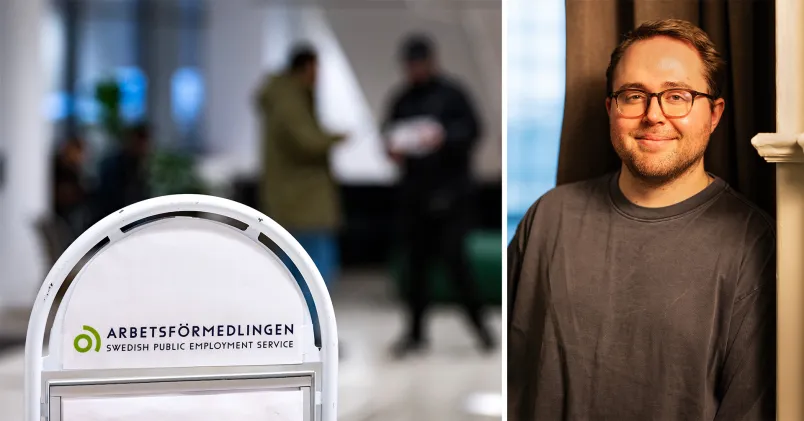
Att gå en utbildning på Yrkeshögskolan kan vara ett snabbt sätt att få jobb efter en kort utbildning. Åtminstone har det varit så tidigare. Men de senaste åren har andelen studenter i arbete efter examen minskat och i år är inget undantag.
Av de examinerade 2024 har 81 procent fått ett jobb i år, vilket är en minskning med tre procent jämfört med året innan. Även andelen som fått ett jobb som överensstämmer med utbildningen minskar. Lägst siffra har de som läst en IT-utbildning. Där har endast en tredjedel fått ett jobb som motsvarar utbildningen de läste på yrkeshögskolan.
En av dem som har erfarenhet av yrkeshögskolan är Carl Broman, som läser ett tvåårigt program till mjukvaruutvecklare på Nackademin i Stockholm. Han har goda förhoppningar om ett jobb i framtiden, men är väl medveten om att branschen han ger sig in i har en viss mättnad.
– Konkurrensen därute är stor och som junior-utvecklare så är praktiken jätteviktig. Rekryterare letar efter folk som är självgående. De vill gärna se att man gjort egna projekt, kan planera, genomföra och förklara en IT-lösning.
De som inte är vana att ta första steget har haft det tufft
Några av hans kurskamrater har skickat 50 ansökningar om praktik utan att få svar. Carl Broman har fått napp. Han tror att det kan vara hans bakgrund som säljare som gett honom fördel.
– Jag har legat på, tagit personlig kontakt och försökt att skapa en relation. Det ligger lika mycket hårt jobb bakom kompetensen som att framföra den. De som inte är vana att ta första steget på det sättet har haft det tufft, säger han.
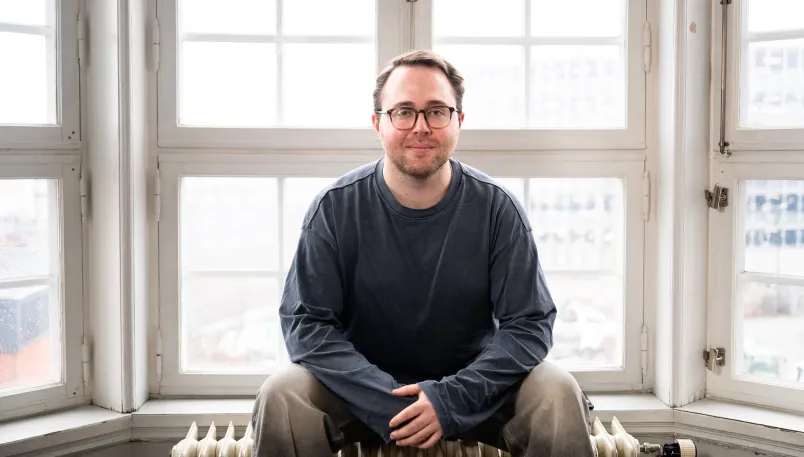
Enligt SCB:s siffror har det blivit svårare för studerande inom två utbildningsområden att etablera sig på arbetsmarknaden. Ett av dem är Carl Bromans framtida bransch, IT/Data. De andra är ekonomi, administration och försäljning. Till de utbildningsinriktningar som hade allra högst andel i jobb hör bland annat specialistundersköterskor, säkerhetssamordnare, elkonstruktörer, kart- och mättekniker och ambulanssjukvårdare.
Orsaken till att andelen studenter som får jobb efter YH- utbildningen minskar är flera. Lågkonjunkturen de senaste åren har inneburit en sämre arbetsmarknad i för alla. Carl Broman tror också att inom hans framtida bransch blir kunskap fort gammal.
– Min bransch utvecklas hela tiden, vilket gör att vi aldrig blir färdiglärda. Dessutom vill många företag ha seniora utvecklare. Att ta in en junior är en större risk eftersom de är som hantverkare och måste ha några lärlingsår innan de blir självgående.
Vilket råd skulle du ge någon som funderar på en YH-utbildning?
– Att tänka på att det är mycket eget ansvar att ta till sig de kunskaper man lär sig. Det går inte att bara lära sig teorin och sedan förvänta sig att få jobb. Du måste gräva vidare själv, vara nyfiken. Det är viktigt att man faktiskt gillar sitt yrke, säger Carl Broman.
Uppgifterna kommer från en årlig uppföljning av examinerade från yrkeshögskolan, som genomfördes av SCB under hösten 2025 bland de som examinerades 2024. Totalt omfattade undersökningen 22 900 personer och svarsfrekvensen var 42 procent.

